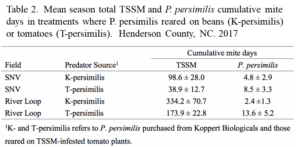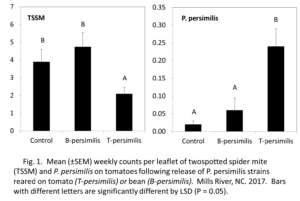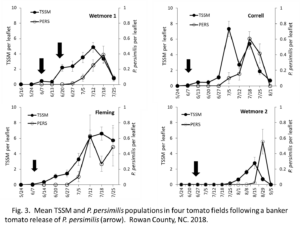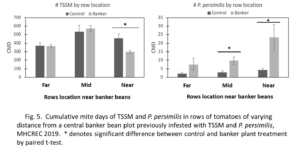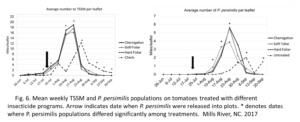Final report for LS17-284
Project Information
- Determine the distribution of resident populations of persimilis in different ecoregions of NC (mountains, piedmont and coastal plains), and overwintering sites in regions where they do successfully overwinter.
- Compare efficacy of different commercial sources and release rates of persimilis in controlling TSSM on tomatoes.
- Determine the level of TSSM suppression in tomatoes using a within field tomato-based banker plant system and a periphery bean-based banker plant system for releasing persimilis into commercial tomato fields.
- Compare different insecticide-based management programs for compatibility with persimilis, efficacy in managing key insect pests, and net profitability of tomato production.
Cooperators
- - Producer
- - Producer
- - Producer
- - Producer
- - Producer
- - Producer
- - Producer
- - Producer
Research
Objective 1. Predator distribution and overwintering survey. During the summer of 2017 and 2018, surveys were conducted in commercial vegetable fields in the mountains (Henderson and Buncombe Counties), piedmont (Rowan County) and coastal plain (Gates, Chowan, Pasquotank, and Sampson Counties) regions of NC. P. persimilis overwintering studies were established in the mountains and coastal plain regions in the fall of 2017. Chickweed flats (1020 trays, 11” W x 21.4” L x 2.4” D) were surrounded by tomato plants infested with TSSM and P. persimilis in three habitat types at 2 locations; woods (pine and mixed hardwood), a weedy field margin adjacent to soybean, and in a small grain field at the Upper Coastal Plain Research Station in Rocky Mount and at MHCREC on 18 and 21-Oct., 2017, respectively. Secondly, in the fall of 2017 four cover crops were seeded into 1 m2 plots at MHCR&EC on 29-Sept.; wheat and rye (19.4 grams per plot), pelletized vetch 9.5 grams per plot), fescue (9.7 grams of KY31), and one control plot consisting of bare soil. We then introduced mite infested (TSSM + P. persimilis) bean or tomato plants into each plot on 20-Oct. Additional tomato plants infested with both TSSM and P. persimilis were placed in an experimental hop yard at MHCREC on 22-Oct. Results were evaluated in April 2018.
Objective 2. Bean vs. tomato-adapted predator release in commercial fields. Field trials were conducted in Henderson (mountains) and Rowan (piedmont) counties from 2017-2019. In 2017, fourteen plots (9 rows x 50 ft) in four blocks were established at two sites to compare two sources of predatory mites and three release sites within plots. TSSM were first detected on 10-July and 17-July at the River Loop and SNV locations, respectively. Subsequently, predatory mites (n = 1,000) were released into each plot (except the control plot) on 20-July at River Loop and on 3-Aug at SNV. Predatory mite sources consisted of those purchased from Koppert Biologicals that were reared on bean (B-persimilis), and our laboratory colony reared on tomato (T-persimilis). P. persimilis were released at 1, 2, and 4 sites per plot, equating to 70, 140, and 280 release sites per acre. The density of predators released per acre remained constant at about 21,000 predators per acre for all releases.
Objective 3a. Tomato banker plant system. A modified tomato banker plant system whereby tomato plants containing both TSSM and P. persimilis were placed in commercial tomato fields to serve as a P. persimilis release method. This release method was conducted in 12 commercial fields between 2017 and 2019. Predator releases included both tomato-reared (produced by us) and bean-reared (purchased from Koppert Biologicals). Following releases, fields were monitored for both TSSM and predatory mites to determine the level of biological control over time and the spread of predators throughout fields. Dates of releases varied among locations based on the infestation level of TSSM in individual fields, but TSSM populations varied from about 0.5 to 2 mites per leaflet. A replicated field study was also conducted to compare the performance and compatibility of the acaricide Acramite with P. persimilis releases. This was conducted to assess the efficacy of biological control plus acaricide versus each alone to determine if P. persimilis releases can prevent the typical resurgence of TSSM following acaricide applications.
Objective 3b. Bean banker plant system. For the banker bean plant system, a double row of beans, Phaseolus vulgaris ‘Blue Lake 274’, was planted in drive rows of commercial tomato fields in Rowan County in 2017. Six 20-meter sections of drive rows were planted with a double row of beans on 22-June, beans were infested with TSSM on 8 July, and then P. persimilis was released in beans on 26 July. In 2018 and 2019, the banker bean study was conducted at the MHCREC in Mills River, NC. Treatments consisted of banker bean plots and control plots. All plots consisted of 10 rows of tomatoes (‘Mountain Majesty’), 25’ long, separated in the middle by a 10’ drive row where banker beans were planted. Plots were separated by 30 ft alleys planted with soybeans to hinder movement of predatory mites. In banker bean plots, 4 rows (25 ft long x 2 ft spacing) of bush beans (‘Blue Lake’), were planted in drive rows between each set of 5-row tomatoes. Beans were direct seeded on 30-May. Tomatoes (5 wk old) were transplanted on 13-June into mulched beds covered with black plastic, with 1.5’ plant spacing and 5’ row spacing. Beans were infested with a laboratory colony of TSSM on 15 July, and P. persimilis (Koppert) were released on 15 August at a rate of 90,000 per acre (~300 P. persimilis released evenly throughout each bean plot). TSSM and P. persimilis were sampled weekly from bean plots and from rows 1, 3, and 5 of each tomato plot on both sides of the drive row. Replicated study data were subjected to ANOVA and means separated by LSD.
Objective 4. Insecticide program efficacy, profitability, and predator compatibility. Different insecticide-based management programs were evaluated for compatibility with P. persimilis, efficacy in managing key insect pests, and net profitability of tomato production at MHCREC in the summer of 2017 and 2018. Tomato transplants set into black-plastic mulched rows on 9 and 6 June in 2017 and 2018, respectively. Plots consisted of three 25-ft long rows of tomatoes planted on 5 ft centers. Each plot was separated by a 25 ft planting of soybean to hinder P. persimilis movement between plots. Three insecticide programs (Table 1) were compared with a non-treated control. Programs included a chemigation treatment where insecticides were injected into driplines, a “soft” foliar program with insecticides considered safe to P. persimilis, and a “hard” foliar program considered the current standard practice that includes broad spectrum insecticides harmful to P. persimilis and other natural enemies. P. persimilis were released in plots at 21,000 per acre when TSSM appeared. In addition to monitoring TSSM and P. persimilis, pest populations were also monitored and tomatoes were harvested weekly as vine ripe fruit and graded for damage and quality. A partial budget analysis was conducted to estimate net profits generated by each treatment by subtracting total profits (based on marketable yield and weekly market prices of tomatoes) from total product costs. Data were subjected to ANOVA and means separated by LSD.
Results and Discussion
Objective 1. Predator distribution and overwintering survey. Resident populations of P. persimilis were observed in about half of tomato fields surveyed in the piedmont county of Rowan; 7 of 14 and 5 of 11 fields in 2017 and 2018, respectively. No resident populations were detected during summer sampling in any of the mountain or coastal plain counties in either year. However, overwintering studies demonstrated that P. persimilis did successfully overwinter at the Upper Coastal Plain Research Station in Rocky Mount, indicating that the predator is likely capable of becoming established. While the climate in the coastal plain is considered ideal for year-around survival of P. persimilis, its absence is likely due to the lack of areas with concentrated and consistent production of crops that support high populations of TSSM, such as that in Rowan County. P. persimilis can only survive on TSSM, and when TSSM decline to very low numbers the predator goes extinct. Rowan County has a long history of commercial tomato production, a crop that is highly susceptible to TSSM because of high fungicide. The high fungicide use is critical because it prevents fungal epizootics from suppressing TSSM populations – fungal epizootics following rain decimate TSSM populations except on those crops frequently sprayed with fungicides. The coastal plain region is dominated by row crops (corn, cotton, soybean) that are infrequently sprayed with fungicides and therefore allow for frequent fungal epizootics that quickly suppress TSSM populations. This is further supported with observations by Rebecca Schmidt-Jerries (personal communication) who detected resident P. persimilis populations in an area of the coastal plain region of South Carolina that has a history of concentrated tomato and strawberry production. The failure to detect resident populations of P. persimilis in the mountains of western NC, where there are high concentrations of tomato production, was due to winter temperatures being too low for survival of P. persimilis.
Objective 2. Bean vs. tomato-adapted predator releases in commercial fields. Studies to compare the effect of host crop on which P. persimilis were produced – TSSM infested tomato (T strain) versus bean (B strain) – showed that host plant did indeed have an effect on how well the predator performed on tomato. When season cumulative mite days were calculated for all treatments, there were no significant differences in either TSSM or P. persimilis populations, although trends showed that TSSM populations were lower and P. persimilis higher in plots where tomato-adapted predators were released (Table 1). When populations were averaged across all sample dates, TSSM populations were significantly lower and P. persimilis higher in the treatment where tomato-adapted persimilis were released compared to either bean-adapted predators or the control. These findings suggest that P. persimilis reared on tomato were better suited for establishing and reducing TSSM populations compared to those reared on beans.
Objective 3a. Tomato banker plant system. During the first year of tomato banker releases in commercial fields in 2017, numerous problems were encountered related to grower application of insecticides toxic to P. persimilis and endemic populations of P. persimilis masking the impact of released predators. One late-season release in Henderson County did demonstrate the potential for releases. Predators were released on 27 August in a field with a growing TSSM population of about 1 mite per leaflet. TSSM populations continued to increase for about 3 weeks when P. persimilis were first detected, after which TSSM populations stabilized at about 7 to 10 mites per leaflet while they increased to 30 mites/leaflet in the non-released section of the field (Fig. 2). These findings of predators becoming established 3 to 4 weeks after release is consistent with previous small plot studies.
In 2018, P. persimilis were released in four commercial tomato fields in Rowan County, with dates of release indicated by the arrows in Fig. 3. Releases were conducted in sections of fields ranging from 0.25 to 1 acre. Wetmore 1 was the only location with two releases of predators, and Correll was the only location where an acaricide application was made – Nealta on 6 July. The goal of studies this year was to release predators at TSSM densities of ≤0.5 mites per leaflet – as soon as possible after initial detection of TSSM in fields. In three fields (Wetmore 1, Fleming and Correll) there was a lag time of 3 to 4 wks between release of P. persimilis and detection in sampling. The Wetmore 2 location was a later planting and there was an apparent 7 wk interval between release and detection, which suggests that the predator population observed in this field was an endemic population. It is noteworthy that releases helped maintain TSSM populations below the economic injury level of 8 mites/leaflet in all fields. These results indicate that early season releases of P. persimilis within a single tomato row at a rate of ~21,000 an acre when TSSM average ~1 per leaflet can successfully reduce their populations after 4 – 5 weeks.
As a potential system to reduce the cost of biological control with P. persimilis, in 2019 a single release (inoculation) of predators occurred on one edge of a tomato field, spread across a 2.5 acre field was monitored. Subsequent monitoring showed that released predators spread across the entire field over a six-wk period (Fig. 4). Additional work will be necessary to determine the influence of TSSM population density on the rate of spread, and the identification of spatial release points to more efficiently achieve dispersal of the predator across a field. 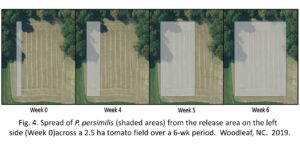
Objective 3b. Bean banker plant system. These experiments were conducted in a commercial tomato field in Rowan County in 2017 and at the Mountain Horticultural Crops Research Station in Mills River in 2018 and 2019. In 2017 in the commercial field at the Correll Farm, an endemic population of P. persimilis invaded the field and masked the effect of the banker plant study. In 2018, record rainfall at the MHCREC (37 inches of rain between May and August) prevented TSSM populations from becoming established. In 2019, the banker bean system successfully established P. persimilis and reduced TSSM in adjacent tomato plots. P. persimilis were released in TSSM-infested bean plants where populations increased and dispersed to nearby tomatoes where they became established. Analysis of cumulative mite days (CMD) indicated that P. persimilis populations were significantly higher in tomato rows one (near) and three (mid) away from a central banker bean system (Fig. 5). TSSM populations were significantly reduced in adjacent (near) tomatoes only. The effects of TSSM population suppression through P. persimilis predation in this experiment were likely reduced by significant damage incurred to the banker beans from weekly spray equipment and an unsupervised tomato harvesting crew. Despite this significant damage to the banker beans, it is noteworthy that P. persimilis still established and dispersed to suppress TSSM.
Objective 4. Insecticide program efficacy, profitability, and predator compatibility. In 2017 and 2018 there were no differences among insecticide programs in secondary pests, including thrips and flea beetles, but potato aphid populations were higher in the control than insecticide treatments. Also, there were no differences among insecticide programs in either total or marketable yields (Table 3), nor in net profits generated by any insecticide program, all of which were significantly higher than the non-treated control. Higher profits in 2017 vs. 2018 were due to a combination of higher yields and price of tomatoes in 2017. High rainfall in 2018 was responsible for reduced yields. Insect damage was relatively high in the control in both years, reaching 25.6 and 33.9% of fruit in 2017 and 2018, respectively. The cause of insect damage in each year was due to three groups of pests; lepidopterans, thrips and stink bugs. Damage was split evenly among the three groups of pests in 2017, with 8.5, 6.0, and 8.5% damage caused by lepidopterans, thrips, and stink bugs respectively. In 2018 lepidopterans were responsible for 91.5% of all insect-damaged fruit. High populations of cabbage looper were a primary cause of this damage in 2018. Soil application of Coragen (for lepidopteran control in the chemigation treatment) is known to be less effective against this insect than other lepidopterans, and was the cause of higher insect damage in the chemigation treatment in 2018.
TSSM and P. persimilis populations in the chemigation, soft foliar, and control treatments did not differ from each other on any sampling date in 2017 (Fig 6). However, TSSM populations did increase to higher densities in these treatments compared to the “hard” insecticide treatment, which was the result of pyrethroids with acaricide activity being applied to this treatment (i.e., Brigade and Warrior). Typically there is a resurgence of TSSM following suppression with pyrethroid insecticides, but that was not observed in this study. However, P. persimilis populations did develop to significantly higher densities in the chemigation treatment, soft insecticide treatment, and control compared to the conventional hard insecticide treatment . P. persimilis peaked one week after TSSM peaked and were responsible for the dramatic decline in TSSM densities in the three former treatments from 17 to 23-Aug., indicating effective biological control of TSSM in the absence of acaricides. Heavy rains in 2018 resulted in extremely low TSSM densities; highest density occurred in the hard foliar treatment at 2.5 mites/leaflet on the last sample date, and populations never exceeded 1 per leaf in any of the other treatments.
Education
The educational program targeted cooperative extension agents, commercial vegetable growers (both conventional and organic producers), as well as the pest management community (chemical distributors, producers of beneficial insects, and basic chemical manufacturers). Several approaches were used to reach a diverse audience, including on-farm tests and demonstrations, field-days, a training workshop for extension agents and other interested people, presentations at commodity meetings, development of hardcopy and web-available extension publications, and a website dedicated to biological control of spider mites in vegetable crops. Information was also delivered to the scientific community through presentations at scientific conferences and publications in scientific journals.
Educational & Outreach Activities
Participation Summary:
On-farm tests and demonstrations: Tests or demonstrations were conducted annually on seven to eight commercial tomato farms from 2017 to 2019. These consisted of weekly visits to each farm to monitor TSSM populations in tomato fields and to make releases of P. persimilis when TSSM populations reached predetermined densities. After field work was completed at each site, growers were visited and informed of pest densities in fields and to discuss their upcoming pest control actions relative to TSSM populations. At three farms over the course of the project, replicated trials were conducted to compare sources of P. persimilis and evaluate the banker bean release strategy. This activity was especially valuable in teaching growers about the specifics of P. persimilis biological control and how to preserve them by adjusting pesticide use.
Presentations:
Walgenbach, JF. 2018. Whitefly and spider mite management. Winter Vegetable Conference. Feb 22. Asheville, NC (95 attendance)
Walgenbach JF. 2018. Good bugs and bad bugs; how they interact. Transylvania County Master Gardner’s, March 28. MHCREC, Mills River, NC (35 attendance)
Walgenbach, JF, T. Bilbo and A. Alaniz. 2019. Population dynamics and biological control of Tetranychus urticae in North Carolina tomato Systems. 11th Spider Mite Genome Meeting. Logrono, La Rioja, Spain. Nov 5, 2019. (35 attendance)
Walgenbach, JF. 2019. Augmentation and conservation biological control in vegetables. Southeast Regional Fruit and Vegetable Conference, Savannah, GA. Jan 11, 2019. (50 attendance)
Walgenbach, JF and J Golec. 2019. Biological control of spider mites in tomatoes. NC Tomato Growers Association Winter Vegetable Conference. Asheville, NC, Feb 20, 2019. (110 attendance)
Walgenbach, JF. 2019. Good bugs and bad bugs. Transylvania County Master Gardeners. March 20, 2019. (27 attendance)
Bilbo, TR and JF Walgenbach. 2019. Insect and mite management in fruiting vegetables. NC Vegetable Growers Association Annual AgExpo, December 7, 2019, Wilmington, NC (40 attendance)
Bilbo, TR and JF Walgenbach. 2020. Managing mites and thrips in high-value vegetable production. NC Tomato Growers Association Winter Vegetable Conference. Asheville, NC, Feb 19, 2020. (85 attendance)
Posters:
Owens D, T. Ohmen, D Olvera, and J Walgenbach. 2017. Management of twospotted spider mite with Phytoseiulus persimiis in tomatoes. National Meeting of Entomological Society of America. Nov 7, 2017, Denver, CO
Golec J and JF Walgenbach. 2018. Twospotted spider mite management in tomatoes using Phytoseiulus persimilis. Entomological Society of America Annual Meeting. Nov 14, 2018, Vancouver, BC, Canada.
Field day presentations:
Owens D and J Walgenbach. 2017. Biological control of twospotted spider mite. NC Tomato Growers Assn Field Day, Aug 10, 2017 (225 attendance).
Golec J and J Walgenbach. 2018. Compatibility of insecticide programs with biocontrol by Phytoseiulus persimilis. NC Tomato Growers Assn Field Day , Aug 16. MHCREC, Mills River, NC (210 attendance)
Bilbo T and J Walgenbach. 2019. Use of banker plants to release Phytoseiulus persimilis in tomato fields. NC Tomato Growers Assn Field Day Aug 8. MHCREC, Mills River (250 attendance)
Agent Training Workshops:
Walgenbach, JF and TR Bilbo. 2019. Biological control in fruiting vegetables. Agent-training workshop. July 23-24, 2019, Salisbury, NC (26 attendance)
Walgenbach, JF. 2020. Insect and mite management in greenhouse vegetables. Presentation at Greenhouse Vegetable Production agent training workshop. January 22, 2020, Raleigh, NC. (47 attendance)
Walgenbach, JF. 2020. Insect and mite management in greenhouse vegetables. Presentation at Under Cover Tomato Production agent training workshop. March 10, 2020, Knoxville, TN. (18 attendance)
Websites:
Bilbo, TR, SC Schoof and JF Walgenbach. Biological control with predators and parasites. NC Cooperative Extension Service. https://entomology.ces.ncsu.edu/biological-control-with-predators-and-parasitoids/
Bilbo, TR and JF Walgenbach. Biological control of spider mites in tomatoes: Phytoseiulus persimilis, a predatory mite that devours twospotted spider mite. NC Cooperative Extension Service. https://entomology.ces.ncsu.edu/biological-control-of-spider-mites-in-tomatoes/
Bilbo, TR, SC Schoof and JF Walgenbach. Benefits of Applying Insecticides With Drip Chemigation. NC Cooperative Extension Service. https://entomology.ces.ncsu.edu/benefits-of-applying-insecticides-with-drip-chemigation/
Publications:
Golec, JR, B Hoge and JF Walgenbach. 2020. Effect of biopesticides on different Tetranychus urticae Koch (Acari: Tetranychidae) life stages. Crop Prot. 128: 105015. https://doi.org/10.1016/j.cropro.2019.105015
Bilbo, TR and JF Walgenbach. 2020. Compatibility of bifenazate and the predatory mite, Phytoseiulus persimilis, for management of twospotted spider mites in North Carolina staked tomatoes. J. Econ. Entomol. (accepted)
Leveraged funding:
Walgenbach, JF. 2017. Augmentation of Phytoseiulus Persimilis for Biological Control of Twospotted Spider Mite in Tomatoes. NC Tomato Growers Assn. $2,000.
Schmidt-Jeffris, R, JC Chong, J Walgenbach, O Liburd, R. Srinivasan, L David, B Dutta, T Cooling. 2018. Development and implementation of biological control tactics for key vegetable insect pests in the southeastern US. USDA-NIFA-OREI. $999,992 ($222,548 to NCSU).
Walgenbach, JF and TR Bilbo. 2020. Determiation of the overwintering ecology of the predatory mite Phytoesiulus persimilis for improved control of the twospotted spider mite. NC Tomato Growers Assn. $2,000.
Learning Outcomes
A survey conducted at the Winter Vegetable Conference in Asheville in February 2018, one year into the project, revealed that 70% of respondents correctly identified Phytoseiulus persimilis, but only 2% of respondents indicated safety to biological agents was a factor when choosing an insecticide. Consequently, toxicity of insecticides to natural enemies was emphasized, particularly replacement of broad spectrum pyrethroids that are highly toxic to P. persimilis. On-farm tests and consultations with other growers conducted during 2019 revealed that most growers had eliminated pyrethroid insecticides form their management programs, as had several sales persons of chemical distribution companies.
Among the 8 growers where on-farm demonstrations were conducted, 7 have modified their management programs to incorporate P. persimilis conservation practices by eliminating pyrethroid insecticides and incorporation of TSSM thresholds so as to allow natural populations of predators to become established.
In 2019, two growers were releasing P. persimilis in their fields, including one who refused to conduct tests in 2017 because of lack of confidence in P. persimilis as a management strategy
Project Outcomes
Endemic populations of P. persimilis in NC is restricted to areas with cropping systems that consistently (annually) produce high populations of TSSM.
Selective insecticide based biocontrol conservation programs preserved P. persimilis populations in tomatoes, leading to biological control of TSSM and reductions in acaricide use.
Release of either tomato-adapted or bean-adapted P. persimilis in tomato fields at 21,000 predators per acre when TSSM populations averaged ≤0.5 mites/leaflet suppressed TSSM populations within three to four weeks after release.
The use of a banker bean strategy for P. persimilis was successful in establishing predator populations in tomato fields.
Twenty five extension agents were trained in biological control of TSSM by P. persimilis.
This project successfully developed a system for releasing P. persimilis for biological control of twospotted spider mites in tomatoes. An obstacle to implementation is the high cost of predators when released at 21,000 per acre in areas where endemic populations of the predator do not exist (about $300/acre), and promoting early season invasion in areas where P. persimilis is endemic. Future studies should focus on a more strategic spatial release strategy to take advantage of the predator’s high dispersal rate within fields, a better understanding of the overwintering ecology of P. persimilis to identify the relationship between overwintering populations and host crops, and habitat manipulation strategies to promote early season invasion of predators in TSSM susceptible crops.

